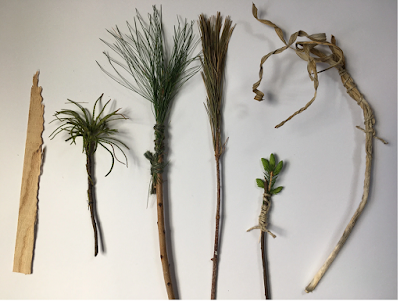I posted a photo of my mini-collages on Instagram @janedaviesart and got an interesting question:
Is there a purpose to making these and saving them? I’m
asking because I tend to purge art that is not created for display. I
have mixed feelings because I enjoy the creative process, but it’s not
really a piece of art, per se.
I invited an e-mail conversation so that I could address this question that many artists have: if it isn't practical or doesn't make a salable piece, what is its value?
Here are some of the mini-collages:
 |
| These are each 4.5"x6" on Bristol, collage pieces are painted papers. My 'rule' was to use three shapes only, three different colors, on each one. The next step is to crop them, visually, at least. to see if I can make interesting negative spaces. |
Here is the conversation:
Q:
My main question was if you had a purpose in mind when you created these simplified works, if you save them, and how you view the time spent creating them. Are you working towards a goal or just doing them for relaxation?
A: When I need a break from whatever larger work I’m doing, OR when I’ve been out of the studio for a while and am rusty, the best way to get ideas moving is to keep my hands and eyes DOING something in the studio. Not thinking, but doing. And that takes on many forms. This little exercise I just made up and did a LOT of them. The main point is to do SOMETHING with hands and eyes to generate ideas, see where it goes, keep in practice, jog something loose, get back to some basic ideas, etc. It is not for relaxation, though it might be relaxing.
Q:
I tend to feel guilty if I spend a lot of time and money on materials with art ‘just for fun and relaxation’ vs. a finished piece. I could make dozens of simpler works, but I’m not sure what I’d do with them except throw them in the trash eventually! My Inner Critic tells me that it’s silly to waste time just doing things for the fun in the moment and then throwing them away, since there is no practical use for them.
A: Yeah. I hear you. And probably so does every other artist, especially women. 'Be Useful, Be Practical, Be Thrifty or you are wasting time, wasting space, wasting money', etc. is a strong inner voice in our culture. It reveals our own lack of confidence in the value of our work, and in the value of art generally. In my view, the value has to start with YOU, the artist, not someone else putting a price on it or putting it to practical use. This shift in attitude takes years and constant vigilance. When there is stuff To Be Done (practical), and I am in my studio making useless little collages, my belief in their value has to be stronger than the voice saying I Should Weed The Garden.
I can not make good, real, art that is truly mine unless I constantly explore, constantly make and observe, and allow myself the space-time-money to make work that does not see the light of day.
To tell you the truth I do not know what will become of my little collages, and that is the furthest thing from my mind as I am creating them. It’s paint, paper, matte medium (for the glue), a little time, a little process-focus. To me the value is in doing it and “keeping in shape” as an artist.
Q: I’d love to hear your take on it; why you create so many simple, practice works, with good materials. What is the purpose, what do you do with them, etc., so that I can stop feeling guilty when I “play” and spend time lots of time just for the sake of enjoying my materials, and the end product has no real purpose other than the joy of creating in the moment, unworthy of sharing as a piece of art.
A: I don’t think of them as ‘practice works’. Doing them is just part of Doing The Work as an artist. I recommend to my students to keep the focus on process and on developing and maintaining a HEALTHY ART PRACTICE. The good, genuine pieces of art, art that is yours, is a byproduct of your healthy art practice. Let it show up on its own, don’t force it.


























